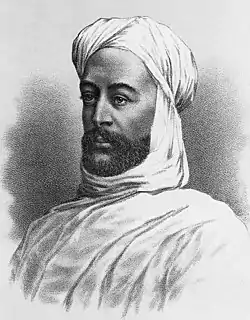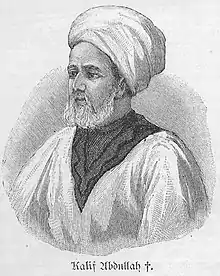Mahdist State
The Mahdist State, also known as Mahdist Sudan or the Sudanese Mahdiyya, was state based on a religious and political movement launched in 1881 by Muhammad Ahmad bin Abdullah (later Muhammad al-Mahdi) against the Khedivate of Egypt, which had ruled the Sudan since 1821. After four years of struggle, the Mahdist rebels overthrew the Ottoman-Egyptian administration and established their own "Islamic and national" government with its capital in Omdurman. Thus, from 1885 the Mahdist government maintained sovereignty and control over the Sudanese territories until its existence was terminated by the Anglo-Egyptian forces in 1898.
Mahdist State الدولة المهدية Al-Dawla al-Mahdiyah | |||||||||||
|---|---|---|---|---|---|---|---|---|---|---|---|
| 1885–1899 | |||||||||||
 One of the flags of the Mahdi movement; most Mahdist flags varied in color but were similar to this one in their style.[1] | |||||||||||
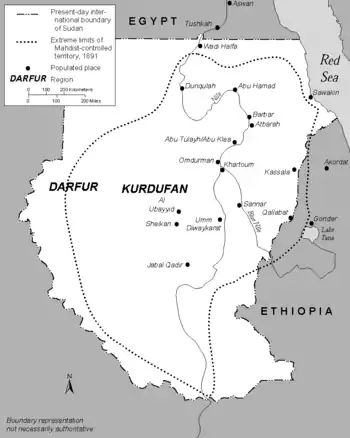 Extreme limits of Mahdist-controlled territory (area enclosed by dotted line; 1891) | |||||||||||
| Status | Unrecognized state | ||||||||||
| Capital | Omdurman | ||||||||||
| Common languages | Arabic and other languages of Sudan | ||||||||||
| Religion | Sunni Islam | ||||||||||
| Government | Islamic state | ||||||||||
| Mahdi | |||||||||||
• 1881–1885 | Muhammad Ahmad | ||||||||||
| Khalifa | |||||||||||
• 1885–1899 | Abdallahi ibn Muhammad | ||||||||||
| Legislature | Shura council[2] | ||||||||||
| Historical era | Scramble for Africa | ||||||||||
| 1881–1885 | |||||||||||
| 26 January 1885 | |||||||||||
• Sudan Convention | 18 January 1899 | ||||||||||
| 24 November 1899 | |||||||||||
| Population | |||||||||||
• Pre-Mahdist[3] | 7,000,000 | ||||||||||
• Post-Mahdist[3] | 2,000,000–3,000,000 | ||||||||||
| Currency | Legal tender:[4] Riyal maqbul (silver) De facto currencies:[4] Ottoman riyal majidi, Spanish dollar, Maria Theresa thaler | ||||||||||
| ISO 3166 code | SD | ||||||||||
| |||||||||||
| Today part of | |||||||||||
Mohammed Ahmed al-Mahdi enlisted the people of Sudan in what he declared a jihad against the administration that was based in Khartoum, which was dominated by Egyptians and Turks. The Khartoum government initially dismissed the Mahdi's revolution; he defeated two expeditions sent to capture him in the course of a year. The Mahdi's power increased, and his call spread throughout the Sudan, with his movement becoming known as the Ansar. During the same period, the 'Urabi revolution broke out in Egypt, with the British occupying the country in 1882. Britain appointed Charles Gordon as General-Governor of Sudan. Months after his arrival in Khartoum and after several battles with the Mahdi rebels, Mahdist forces captured Khartoum, and Gordon was killed in his palace. The Mahdi did not live long after this victory, and his successor Abdallahi ibn Muhammad consolidated the new state, with administrative and judiciary systems based on their interpretation of Islamic law.
Sudan's economy was destroyed during the Mahdist War and famine; war and disease reduced the population by half.[5][6][7][8] Muhammad Ahmad al-Mahdi declared all people who did not accept him as the awaited Mahdi to be infidels (kafir), ordered their killing and took their women and property. He destroyed Khartoum, the city that was built by the Ottomans. All buildings were demolished and ransacked. The women were raped and forced to divorce their “kafir” husbands. It was only after the British came back after about 15 years that the city was rebuilt. By this time no historical buildings, Ottoman style mosques and architecture remained.[9]
The British reconquered the Sudan in 1898, ruling it after that in theory as a condominium with Egypt but in practice as a colony.
History
Background
Developments in Sudan during the late 19th century were heavily influenced by the British position in Egypt. In 1869, the Suez Canal opened and quickly became Britain's economic lifeline to India and the Far East. To defend this waterway, Britain sought a greater role in Egyptian affairs. In 1873, the British government therefore supported a programme whereby an Anglo-French debt commission assumed responsibility for managing Egypt's fiscal affairs. This commission eventually forced khedive Ismail to abdicate in favour of his more politically acceptable son, Tawfiq (1877–1892).
After the removal in 1877 of Ismail, who had appointed him to the post, Charles George Gordon resigned as governor general of Sudan in 1880. His successors lacked direction from Cairo and feared the political turmoil that had engulfed Egypt. As a result, they failed to continue the policies Gordon had put in place. The illegal slave trade revived, although not enough to satisfy the merchants whom Gordon had put out of business. The Sudanese army suffered from a lack of resources, and unemployed soldiers from disbanded units troubled garrison towns. Tax collectors arbitrarily increased taxation.
Muhammad Ahmad
In this troubled atmosphere, Muhammad Ahmad ibn as Sayyid Abd Allah, a fakir, or holy man, who combined personal magnetism with religious zealotry, emerged, determined to expel the Turks and restore Islam to its primitive purity. The son of a Dongola boatbuilder, Muhammad Ahmad had become the disciple of Muhammad ash Sharif, the head of the Sammaniyah order. Later, as a sheikh of the order, Muhammad Ahmad spent several years in seclusion and gained a reputation as a mystic and teacher. In 1880, he became a Sammaniyah.
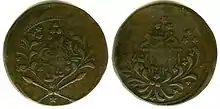
In 1881, Muhammad Ahmad proclaimed himself the Mahdi ("expected one"). Some of his most dedicated followers regarded him as directly inspired by Allah. He wanted Muslims to reclaim the Quran and hadith as the foundational sources of Islam, creating a just society. Specifically relating to Sudan, he claimed its poverty was a virtue and denounced worldly wealth and luxury. For Muhammad Ahmad, Egypt was an example of wealth leading to impious behavior.[10]
Even after the Mahdi proclaimed a jihad, or holy war, against the Turkiyah, Khartoum dismissed him as a religious fanatic. The Egyptian government paid more attention when his religious zeal turned to denunciation of tax collectors. To avoid arrest, the Mahdi and a party of his followers, the Ansar, made a long march to Kurdufan, where he gained a large number of recruits, especially from the Baggara. From a refuge in the area, he wrote appeals to the sheikhs of the religious orders and won active support or assurances of neutrality from all except the pro-Egyptian Khatmiyyah. Merchants and Arab tribes that had depended on the slave trade responded as well, along with the Hadendoa Beja, who were rallied to the Mahdi by an Ansar captain, Osman Digna.
Advancing attacks
Early in 1882, the Ansar, armed with spears and swords, overwhelmed a British-led 7,000-man Egyptian force not far from Al Ubayyid and seized their rifles, field guns and ammunition. The Mahdi followed up this victory by laying siege to Al Ubayyid and starving it into submission after four months. The Ansar, 30,000 men strong, then defeated an 8,000-man Egyptian relief force at Sheikan. Next the Mahdi captured Darfur and imprisoned Rudolf Carl von Slatin, an Austrian in the khedive's service, who later became the first Egyptian-appointed governor of Darfur Province.
The advance of the Ansar and the Hadendowa rising in the east imperiled communications with Egypt and threatened to cut off garrisons at Khartoum, Kassala, Sennar, and Suakin and in the south. To avoid being drawn into a costly military intervention, the British government ordered an Egyptian withdrawal from Sudan. Gordon, who had received a reappointment as governor general, arranged to supervise the evacuation of Egyptian troops and officials and all foreigners from Sudan.
British response


After reaching Khartoum in February 1884, Gordon soon realized that he could not extricate the garrisons. As a result, he called for reinforcements from Egypt to relieve Khartoum. Gordon also recommended that Zubayr, an old enemy whom he recognized as an excellent military commander, be named to succeed him to give disaffected Sudanese a leader other than the Mahdi to rally behind. London rejected this plan. As the situation deteriorated, Gordon argued that Sudan was essential to Egypt's security and that to allow the Ansar a victory there would invite the movement to spread elsewhere.
Increasing British popular support for Gordon eventually forced Prime Minister William Gladstone to mobilize a relief force under the command of Lord Garnet Joseph Wolseley. A "flying column" sent overland from Wadi Halfa across the Bayuda Desert bogged down at Abu Tulayh (commonly called Abu Klea), where the Hadendowa broke the British line. An advance unit that had gone ahead by river when the column reached Al Matammah arrived at Khartoum on 28 January 1885, to find the town had fallen two days earlier. The Ansar had waited for the Nile flood to recede before attacking the poorly defended river approach to Khartoum in boats, slaughtering the garrison, killing Gordon, and delivering his head to the Mahdi's tent. Kassala and Sennar fell soon after, and by the end of 1885, the Ansar had begun to move into the southern region. In all Sudan, only Sawakin, reinforced by Indian army troops, and Wadi Halfa on the northern frontier remained in Anglo-Egyptian hands.
Abdallahi ibn Muhammad
Six months after the capture of Khartoum, the Mahdi died of typhus (22 June 1885). The task of establishing and maintaining a government fell to his deputies—three caliphs chosen by the Mahdi in emulation of the Prophet Muhammad. Rivalry among the three, each supported by people of his native region, continued until 1891, when Abdallahi ibn Muhammad, with the help primarily of the Baqqara Arabs, overcame the opposition of the others and emerged as unchallenged leader of the Mahdiyah. Abdallahi—called the Khalifa (successor)—purged the Mahdiyah of members of the Mahdi's family and many of his early religious disciples.
Originally, the Mahdiyah functioned as a jihad state, run like a military camp. Sharia courts enforced Islamic law and the Mahdi's precepts, which had the force of law. After consolidating his power, the Khalifa instituted an administration and appointed Ansar (who were usually Baqqara) as amirs over each of the several provinces. The Khalifa also ruled over rich Al Jazirah. Although he failed to restore this region's commercial wellbeing, the Khalifa organized workshops to manufacture ammunition and to maintain river steamboats.
Regional relations remained tense throughout much of the Mahdiyah period, largely because of the Khalifa's commitment to using jihad to extend his version of Islam throughout the world. For example, the Khalifa rejected an offer of an alliance against the Europeans by Emperor Yohannes IV of Ethiopia (reigned 1871-1889). In 1887, a 60,000-man Ansar army invaded Ethiopia, penetrated as far as Gondar, and captured prisoners and booty. The Khalifa then refused to conclude peace with Ethiopia. In March 1889, an Ethiopian force, commanded by the emperor, marched on Metemma; however, after Yohannes fell in the ensuing Battle of Gallabat, the Ethiopians withdrew. Abd ar Rahman an Nujumi, the Khalifa's best general, invaded Egypt in 1889, but British-led Egyptian troops defeated the Ansar at Tushkah. The failure of the Egyptian invasion ended the myth of the Ansars' invincibility. The Belgians prevented the Mahdi's men from conquering Equatoria, and in 1893, the Italians repulsed an Ansar attack at Akordat (in Eritrea) and forced the Ansar to withdraw from Ethiopia.
Reconquest of Sudan
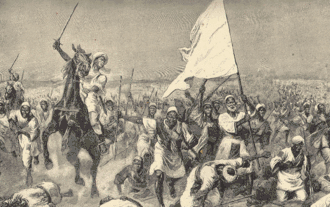
Part of a series on the |
||||||||||||||||||||||
|---|---|---|---|---|---|---|---|---|---|---|---|---|---|---|---|---|---|---|---|---|---|---|
| History of Sudan | ||||||||||||||||||||||
 | ||||||||||||||||||||||
| Before 1956 | ||||||||||||||||||||||
|
||||||||||||||||||||||
| Since 1955 | ||||||||||||||||||||||
|
||||||||||||||||||||||
| By region | ||||||||||||||||||||||
| By topic | ||||||||||||||||||||||
|
||||||||||||||||||||||
| Timeline | ||||||||||||||||||||||
In 1892, Herbert Kitchener (later Lord Kitchener) became sirdar, or commander, of the Egyptian army and started preparations for the reconquest of Sudan. The British thought they needed to occupy Sudan in part because of international developments. By the early 1890s, British, French, and Belgian claims had converged at the Nile headwaters. Britain feared that the other colonial powers would take advantage of Sudan's instability to acquire territory previously annexed to Egypt. Apart from these political considerations, Britain wanted to establish control over the Nile to safeguard a planned irrigation dam at Aswan.
In 1895, the British government authorized Kitchener to launch a campaign to reconquer Sudan. Britain provided men and matériel while Egypt financed the expedition. The Anglo-Egyptian Nile Expeditionary Force included 25,800 men, 8,600 of whom were British. The remainder were troops belonging to Egyptian units that included six battalions recruited in southern Sudan. An armed river flotilla escorted the force, which also had artillery support. In preparation for the attack, the British established an army headquarters at the former rail head Wadi Halfa and extended and reinforced the perimeter defenses around Sawakin. In March 1896, the campaign started as the Dongola Expedition. Despite taking the time to reconstruct Ishma‘il Pasha's former 3 ft 6 in (1,067 mm) gauge railway south along the east bank of the Nile, Kitchener captured the former capital of Nubia by September.[11] The next year, the British then constructed a new rail line directly across the desert from Wadi Halfa to Abu Hamad,[12] which they captured in the Battle of Abu Hamed on 7 August 1897.[13] (The 3 ft 6 in (1,067 mm) gauge, hastily adopted to make use of available rolling stock, meant supplies from the Egyptian network required transshipment via steamer from Asyut to Wadi Halfa. The Sudanese system retains the incompatible gauge to this day.) Anglo-Egyptian units fought a sharp action at Abu Hamad, but there was little other significant resistance until Kitchener reached Atbarah and defeated the Ansar. After this engagement, Kitchener's soldiers marched and sailed toward Omdurman, where the Khalifa made his last stand.[14]
On 2 September 1898, the Khalifa committed his 52,000-man army to a frontal assault against the Anglo-Egyptian force, which was massed on the plain outside Omdurman. The outcome was never in doubt, largely because of superior British firepower. During the five-hour battle, about 11,000 Mahdists died, whereas Anglo-Egyptian losses amounted to 48 dead and fewer than 400 wounded.
Mopping-up operations required several years, but organized resistance ended when the Khalifa, who had escaped to Kordufan, died in fighting at Umm Diwaykarat in November 1899.[14] Although the Khalifa had retained considerable support until his death,[14] many areas welcomed the downfall of his regime. Sudan's economy had been all but destroyed during his reign and the population had declined by approximately one-half because of famine, disease, persecution, and warfare. Millions had died in Sudan from foundation of the Mahdist state to its fall.[15][6][7][8] Moreover, none of the country's traditional institutions or loyalties remained intact. Tribes had been divided in their attitudes toward Mahdism, religious brotherhoods had been weakened, and orthodox religious leaders had vanished.
The Mahdiyah
The Mahdiyah (Mahdist regime) imposed traditional Sharia Islamic laws. The state's administration was first properly organized under Khalifa Abdallahi ibn Muhammad who attempted to use the Islamic law to unify the different peoples of Sudan.[14]
Sudan's new ruler also authorized the burning of lists of pedigrees and books of law and theology because of their association with the old order and because he believed that the former accentuated tribalism at the expense of religious unity.
The Mahdiyah has become known as the first genuine Sudanese nationalist government. The Mahdi maintained that his movement was not a religious order that could be accepted or rejected at will, but that it was a universal regime, which challenged man to join or to be destroyed. The Mahdi modified Islam's five pillars to support the dogma that loyalty to him was essential to true belief. The Mahdi also added the declaration "and Muhammad Ahmad is the Mahdi of God and the representative of His Prophet" to the recitation of the creed, the shahada. Moreover, service in the jihad replaced the hajj, or pilgrimage to Mecca, as a duty incumbent on the faithful. Zakat (almsgiving) became the tax paid to the state. The Mahdi justified these and other innovations and reforms as responses to instructions conveyed to him by God in visions.
The Mahdist regime was also known for its severe persecution of Christians in Sudan, including Copts.[16]
Military
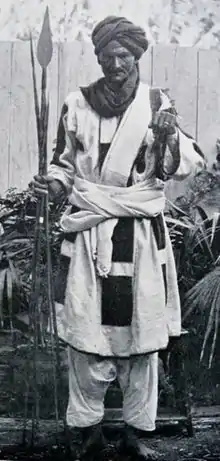
The Mahdist State had a large military which became increasingly professional as time went on.[17] From an early point, the Mahdist armies recruited defectors from the Egyptian Army and organized professional soldiers in the form of the jihadiya, mostly Black Sudanese. These were supported by tribal spearmen and swordsmen as well as cavalry.[18] The jihadiya and some tribal units lived in military barracks, while the rest were more akin to militia.[1] The Mahdist armies also possessed limited artillery, including mountain guns and even machine guns. However, these were few in numbers, and thus only used as defenses for important towns and to arm three river steamers that acted as the state's navy.[19] In general, the Mahdist armies were highly motivated by their belief system. Exploiting this, the Mahdist commanders used their riflemen to screen charges by their melee infantry and cavalry. Such attacks often proved effective, but also led to extremely high losses when employed "unimaginatively".[19] The Europeans generally called the Mahist soldiers "dervishes".[14]
Muhammad Ahmad's early insurgent force which was mostly recruited among the poor Arab communities living at the Nile. The later armies of the Mahdiyah were recuited among various groups, including mostly autonomous groups such as the Beja people.[20] The early forces of the Mahdi were termed the "ansar",[14] and divided into three units led by a Khalifa. These units were termed raya ("flags") in accordance to their standards. The "Black Flag" was mostly recruited from western Sudanese, mainly Baggara, and commanded by Abdallahi ibn Muhammad. The "Red Flag" was led by Muhammad al-Sharif and mostly consisted of riverine recruits from the north. The "Green Flag" under Ali Hilu included troops drawn from the southern tribes living between the White and Blue Nile. After the Mahdi's death, the command of the "Black Flag" was passed to Abdallahi ibn Muhammad's brother Yaqub and became the state's main army, based at the capital Omdurman. [17] As the Mahdist State expanded, provincial commanders raised new armies with separate standards which were modelled on the main armies.[1] The most elite forces within the Mahdist armies were the Mulazimiyya, Abdallahi ibn Muhammad's bodyguards. Commanded by Uthman Shaykh al-Din, these were based at the capital and 10,000 strong, most armed with rifles.[1]
The "flags" were further divided into rubs ("quarters") consisting of 800 to 1200 fighters. In turn, rubs were split into four sections, one administrative, one jihadiya, one sword- and spear-wielding indantry, and one cavalry. The jihadiya units were further split into "standards" of 100 led by officers known as ra's mi'a, and into muqaddamiyya of 25 under muqaddam.[1]
Uniform
At the start of his insurgency, the Mahdi encouraged his followers to wear a similiar clothing in form of the jibba.[14] As a result, the core army of the Mahdi and Abdallahi ibn Muhammad had a relatively regulated appearance from an early point. In contrast, other armies of supporters and allies initially did not adopt the jibba and maintained their traditional appearances. Riverine forces recruited from the Ja'alin tribe and the Danagla mostly wore simple white robes (tobe). The Beja also did not adopt the jibba until 1885.[14]
As time went on and the Mahdist State became better organized under Khalifa Abdallahi ibn Muhammad's leadership, its armies became more and more professional. By the 1890s factories in Omdurman and provincial centers were mass-producing jibba to provide the troops with clothing. Although the jibba still varied in their style, with certain tribes and armies favoring certain patterns and colors, the Mahdist forces became increasingly professional in appearance. The jibba also indicated a fighter's rank within the Mahdist armies. Lower-ranking commanders (emirs) wore more colorful and elaborate jibba. The most senior military leadership preferred the most simple designs, however, to indicate their piety.[21] The Khalifa wore plain white.[22] Some Mahdist troops possessed mail armour, helmets, and quilted coats, although these were more often used in parades than in combat.[17] One unit within the Mahdist armies, the Mulazimiyya, adopted a full uniform, as all their members wore identical white-red-blue jibba.[1]
Flags
The Mahdist State and its armies had no uniform flags, but still used certain designs repeatedly. Most flags carried four lines of Arabic texts which signified allegiance to God, the Prophet Muhammad, and the Mahdi. The flags were usually white with colored borders, and the text displayed in varying colors. Most military units had their own individual flags.[1]
See also
References
- Knight 2005, p. 37.
- Sidahmed, Abdel Salam; Sidahmed, Alsir (2005). "Khalifa's administration". Sudan. Contemporary Middle East. Routledge. p. 17. ISBN 978-0-415-27417-3.
The Mahdist administration centred around the person of the Khalifa Abdullah, both as the ultimate authority as well as the prime mover of the administrative system and initiator of policy. It has been noted that the Khalifa used to consult with his closest aides (such as his brother Ya'qub, and son 'Uthman Shaykh al-Din), and occasionally call for a meeting of the 'State Council'—apparently an advisory council—to which the Mahdi's surviving companions were invited.
- Metelits, Claire (2009). Inside Insurgency: Violence, Civilians, and Revolutionary Group Behavior. New York University Press. p. 37. ISBN 978-0-8147-9578-1.
Estimates cite that the population of Sudan fell from seven million before the Mahdist revolt to between two and three million after the end of the Mahdist era.
- Abu Shouk, Ahmad Ibrahim; Bjørkelo, Anders, eds. (1996). "A note on currencies". The Public Treasury of the Muslims: Monthly Budgets of the Mahdist State in the Sudan, 1897. The Ottoman Empire and its heritage, v. 5. E. J. Brill. pp. xvii–xviii. ISBN 978-90-04-10358-0.
- Francis Mading Deng, War of Visions: Conflict of Identities in the Sudan p.51
- Jok Madut Jok, War and Slavery in Sudan (2001) p.75
- Edward Spiers, Sudan: The Reconquest Reappraised (1998) p.12
- Henry Cecil Jackson, Osman Digna (1926) p.185
- Nicoll, Fergus (19 May 2005). The Mahdi of Sudan and the Death of General Gordon. The History Press Ltd. ISBN 978-0750932998.
- Cleveland, William L.; Bunton, Martin (2013). A history of the modern Middle East (Fifth edition. ed.). Boulder, CO: Westview Press. p. 114. ISBN 9780813348339.
- Gleichen, Edward ed. The Anglo-Egyptian Sudan: A Compendium Prepared by Officers of the Sudan Government, Vol. 1, p. 99. Harrison & Sons (London), 1905. Accessed 13 Feb 2014.
- Sudan Railway Corporation. "Historical Background Archived 10 July 2013 at the Wayback Machine". 2008. Accessed 13 Feb 2014.
- T. B. Harbottle, George Bruce (1979). Harbottle's Dictionary of Battles (second ed.). Granada. p. 9. ISBN 0-246-11103-8.
- Knight 2005, p. 33.
- Francis Mading Deng, War of Visions: Conflict of Identities in the Sudan (1995) p.51
- Minority Rights Group International, World Directory of Minorities and Indigenous Peoples - Sudan : Copts, 2008, available at: http://www.unhcr.org/refworld/docid/49749ca6c.html [accessed 21 December 2010]
- Knight 2005, p. 36.
- Knight 2005, pp. 36–37.
- Knight 2005, p. 38.
- Knight 2005, p. 24.
- Knight 2005, pp. 34–35.
- Knight 2005, p. 35.
Works cited
 This article incorporates public domain material from the Library of Congress Country Studies document: Thomas Ofcansky. "Sudan: The Mahdiyah, 1884–98". Retrieved 5 August 2010.
This article incorporates public domain material from the Library of Congress Country Studies document: Thomas Ofcansky. "Sudan: The Mahdiyah, 1884–98". Retrieved 5 August 2010.- Knight, Ian (2005) [1st pub. 1989]. Queen Victoria's Enemies (2): Northern Africa (3rd ed.). Oxford: Osprey Publishing. ISBN 978-0-85045-937-1.
Further reading
- Fadlalla, Mohamed H. Short History of Sudan, iUniverse, 30 April 2004, ISBN 0-595-31425-2
- Holt, P. M. "The Mahdia in the Sudan, 1881-1898" History Today (Mar 1958) 8#3 pp 187-195.
- Holt, P. M. (1970). The Mahdist State in the Sudan, 1881-1898 : a study of its origins, development and overthrow. Clarendon. ISBN 0198216602.
- Pradines, Stephane; Khorasani, Manouchehr Moshtagh (2018). "Sufi in War: Persian influence on African weaponry in the 19th century Mahdist Sudan". Journal of Asian and African Studies. XXI, No. 5: 254–270. ISSN 0021-9096.
- Kramer, Robert S. (2010). Holy City on the Nile: Omdurman During the Mahdiyya, 1885-1898. Markus Wiener Publishers. ISBN 1558765166.
- Searcy, Kim (2011). The Formation of the Sudanese Mahdist State: Ceremony and Symbols of Authority 1882-1898. Brill. ISBN 9789004191075.
- Seri-Hersch, Iris (2009). "Confronting a Christian Neighbor: Sudanese Representations of Ethiopia in the early Mahdist Period, 1885-89". International Journal of Middle East Studies. Cambridge University. 41: 247–267. doi:10.1017/S0020743809090655.
- Seri-Hersch, Iris (2019). "'Transborder' Exchanges of People, Things and Representations: Revisiting the Conflict between Mahdist Sudan and Christian Ethiopia, 1885-1889".
- Wilson, Patrick R., ed. (2015). The Mahdist Wars Source Book: Vol. 2: Comprising Materials. The (Virtual) Armchair General Publishing. ISBN 978-0692524732.
